Singapore’s geology is, quite simply, fascinating. Over the last 300 million years, what we now call our little red dot has been under water, above water, and even part of a long chain of volcanoes. All these geological changes are preserved in the rocks under and around us. And we can observe some of them at certain locations in Singapore, such as Sentosa.
Sentosa is the perfect destination to discover Singapore’s rich history and become geologists for a day. One group enthusiastic about field trips are the Singapore geography teachers. Several of them had benefitted from previous EOS-led overseas field trips to Mount Merapi and Mount Batur, both in Indonesia. This time round, the local field trip enabled more teachers to come together to learn from experts and to deepen their subject knowledge.
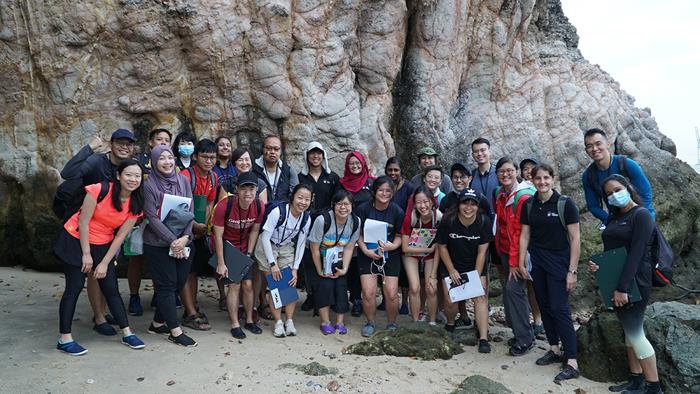
The group of geography teachers and EOS scientists standing in front of an outcrop at Tanjong Rimau (Source: Cheryl Han/Earth Observatory of Singapore)
Close to 25 teachers from Singapore’s secondary schools led by two early career researchers from EOS headed out early at low tide to discover the unique landscape of Sentosa and its geological heritage.
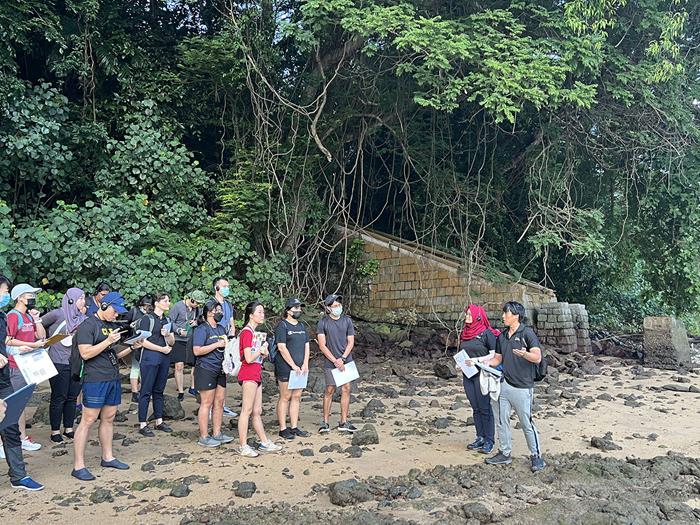 Two of EOS’ PhD students, Gina Sarkawi and Jireh Teo, both on the right, led the first segment of the field trip to Tanjong Rimau (Source: Cheryl Han/Earth Observatory of Singapore)
Two of EOS’ PhD students, Gina Sarkawi and Jireh Teo, both on the right, led the first segment of the field trip to Tanjong Rimau (Source: Cheryl Han/Earth Observatory of Singapore)
Sentosa has well-preserved rock outcrops at its northwestern point, Tanjong Rimau. This site has been the focus of many recent EOS studies as
its corals were discovered to have tracked changes in sea-level. Tanjong Rimau is also one of the main features of the
Sentosa Geology Gallery that we created in partnership with Sentosa Development Corporation.
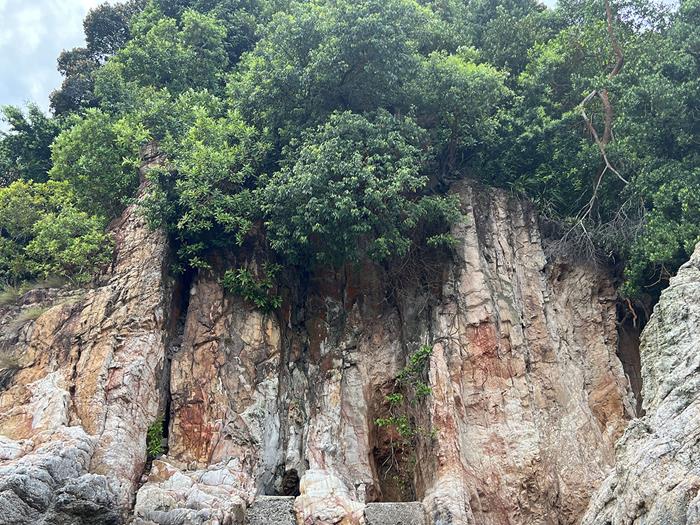 An outcrop at Tanjong Rimau (Source: Cheryl Han/Earth Observatory of Singapore)
An outcrop at Tanjong Rimau (Source: Cheryl Han/Earth Observatory of Singapore)
This outcrop is precious because it contains clues to the history of the island over the last 200 million years – when dinosaurs still roamed the Earth. It includes rock crags skirted by a beach peppered with diverse rocky features. The shore is quite narrow so the only time the rocks are accessible is at low tide.
As we walked along the foot of the crag on sometimes slippery cobbles, we saw rocks of different shapes, sizes and colours. While they may seem nondescript, these rocks gave us a clue about Sentosa’s past environments. These rocks were formed by the transformation of horizontal layers of sediments originally deposited in settings such as river channels, floodplains, lakes, and marine environments. Over the following millions of years, these sediments became the siltstones, sandstones, mudstones, and conglomerates that we see today.
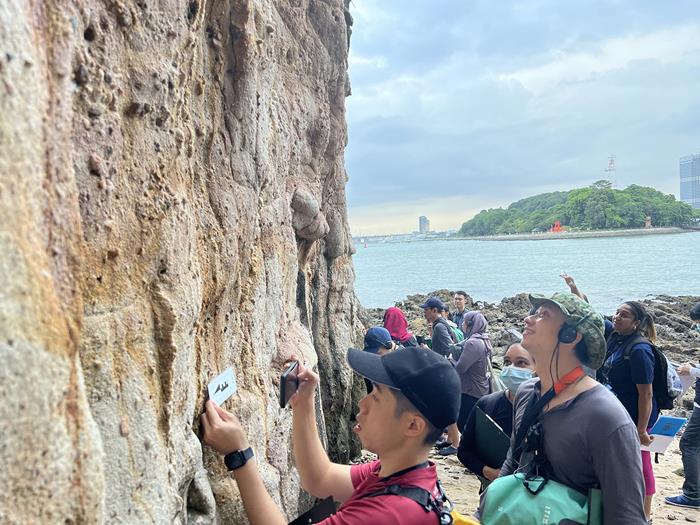 Teachers observing one of Tanjong Rimau’s rock formations (Source: Cheryl Han/Earth Observatory of Singapore)
Teachers observing one of Tanjong Rimau’s rock formations (Source: Cheryl Han/Earth Observatory of Singapore)
At the outcrop, we measured the orientations of the rock layers and saw that the layers are no longer horizontal but near vertical, like books aligned on a bookshelf. Moving such thick layers of rocks requires huge forces: the same forces that move tectonic plates and form mountains. Here, these forces tilted the horizontal rock layers to their current orientation. Evidently, Singapore’s tectonic activity was not always as quiet as it is now.
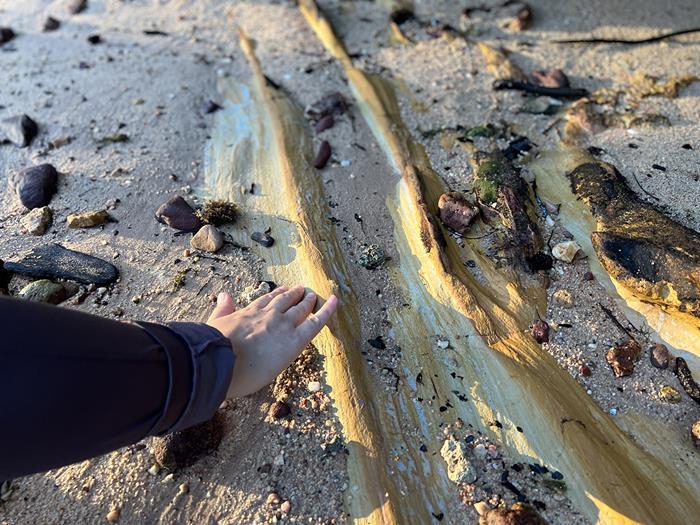 A paleosol rock formation on the beach along the Tanjong Rimau outcrops (Source: Cheryl Han/Earth Observatory of Singapore)
A paleosol rock formation on the beach along the Tanjong Rimau outcrops (Source: Cheryl Han/Earth Observatory of Singapore)
It is amazing how rocks, which might all look quite similar to the naked eye, can tell so many different stories when viewed through a geologist’s eyes.
After visiting Tanjong Rimau, the teachers moved on to the Geology Gallery located at the Sentosa Nature Discovery to learn more about Singapore’s geological history.
There, they learnt
Singapore was once thousands of kilometres away from Kuala Lumpur when an ocean separated the two cities and that there once was volcanic activity in Singapore This was more than 200 million years ago, but some of the signs can be seen in Singapore today.
 Dr Stephen Chua, right, gives the teachers a brief history of Sentosa’s landscape (Source: Cheryl Han/Earth Observatory of Singapore)
Dr Stephen Chua, right, gives the teachers a brief history of Sentosa’s landscape (Source: Cheryl Han/Earth Observatory of Singapore)
With these field trips, we hope to bring the excitement of discovering and understanding how our landscapes are changing and how we piece the information together to reconstruct what happened. By showing that these landscapes contain such a precious heritage, we also hope that participants will feel the importance of conserving them.
This is a vision we share with Sentosa Development Corporation. “We are pleased to collaborate with the Earth Observatory of Singapore to show a lesser-known side of Sentosa and make the knowledge more accessible to our guests through educational efforts like the Sentosa Geology Gallery. We invite guests to discover more interesting stories about Sentosa and ignite a deeper appreciation of Sentosa’s natural heritage,” said Ms Tammy Lim, Deputy Manager for Environmental Management at Sentosa Development Corporation.
“For geography teachers, the field trip served as a rare opportunity to learn the knowledge, methods, and dispositions from field experts, and appreciate the interconnection between the natural and human environments,” said Ms Puay Yin Lim, a Master Teacher in geography at the Academy of Singapore Teachers. “The field trip also served to strengthen the knowledge of the teachers so they can better design field learning for their students. I am very encouraged by the enthusiasm of the younger teachers who felt this learning was the best they have ever had since they became teachers. For this reason, it is necessary for teachers to come together to learn from one another and from field experts.”
We are certainly looking forward to our next adventure together.
This field trip was conducted in collaboration with the Singapore Academy of Singapore Teachers and Sentosa Development Corporation. Tanjong Rimau is a restricted nature area, and the trip there was conducted with permission from Sentosa Development Corporation.